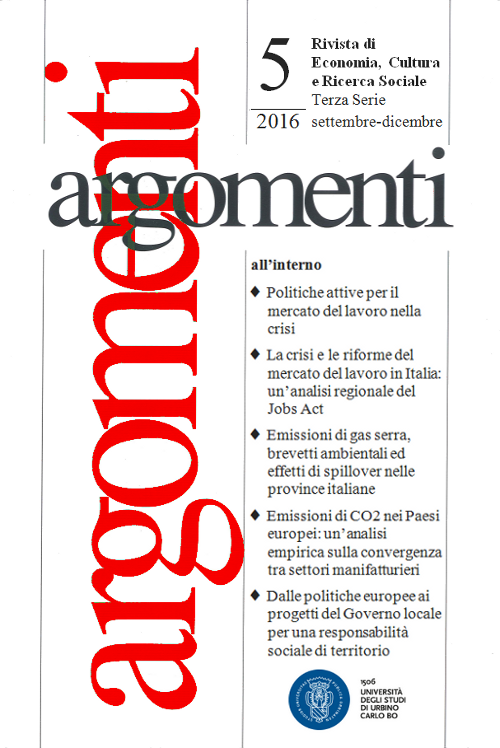Abstract
Questo lavoro si concentra sulle performance ambientali dell’industria manifatturiera europea. L’obiettivo è verificare l’esistenza della convergenza β assoluta e relative e della convergenza σ in termini di produttività ambientale (il rapport tra il valore aggiunto e le emission di anidride carbonica in ciascun settore) in 14 settori per il periodo 1995-2009, utilizzando i dati del database WIOD. I risultati supportano l’ipotesi dell’esistenza di convergenza β assoluta ed evidenziano il ruolo di variabili aggiuntive quali l’apertura al commercio e lo stock di conoscenze nell’influenzare le performance ambientali a livello settoriale. Non è presente evidenza statistica per la convergenza σ.Riferimenti bibliografici
Abrell, J., Ndoye Faye, A. & Zachmann, G. (2011). Assessing the impact of the EU ETS using firm level data. Bruegel Working Paper 2011/08.
Aldy, J.E. (2006). Per Capita Carbon Dioxide Emissions: Convergence or Divergence? Environmental and Resource Economics, 33(4), 533-555. DOI 10.1007/s10640-005-6160-x.
Barassi, M.R., Cole, M.A. & Elliott, R.J.R. (2008). Stochastic Divergence or Convergence of Per Capita Carbon Dioxide Emissions: Re-examining the Evidence. Environmental and Resource Economics, 40(1), 121- 137. DOI 10.1007/s10640-007-9144-1.
Barro, R.J. & Sala-i-Martin, X. (1991). Convergence across States and Regions. Brookings Papers on Economic Activity, 1, 107-182.
Borghesi, S. & Montini, M. (2015). The allocation of carbon emission permits; theoretical aspects and practical problems in the EU ETS. Financialisation, Economy, Society & Sustainable Development (FESSUD) Project, Working Paper 75.
Cole, M.A., Elliott, R.J.R. & Shimamoto K. (2005). Industrial characteristics, environmental regulations and air pollution: an analysis of the UK manufacturing sector. Journal of Environmental Economics and Management, 50(1), 121-143. DOI 10.1016/j.jeem.2004.08.001.
Commissione Europea (2014). For a European Industrial Renaissance. COM 14/2.
Dietzenbacher, E., Los, B., Stehrer, R., Timmer, M. & De Vries, G. (2013). The Construction of World Input-Output Tables in the WIOD Project. Economic Systems Research, 25 (1), 71-98. DOI 10.1080/09535314.2012.761180.
Dinda, S. (2004). Environmental Kuznets Curve Hypothesis: A Survey. Ecological Economics, 49, 431-455. DOI 10.1016/j.ecolecon.2004.02.011.
EEA - European Environment Agency (2014). Resource-efficient green
economy and EU policies (EEA Report 2/2014). Luxembourg, Publications Office of the European Union. DOI 10.2800/18514.
EEA - European Environment Agency (2015). Annual European Union greenhouse gas inventory 1990–2013 and inventory report 2015 (EEA Technical report 19/2015). Luxembourg. Publications Office of the European Union. DOI 10.2800/274962.
Ezcurra, R. (2007). Is there cross-country convergence in carbo dioxide emissions? Energy Policy, 35(2), 1363-1372. DOI 10.1016/j.enpol.2006.04.006.
Herrerias, M.J. (2013). The environmental convergence hypothesis: Carbon dioxide emissions according to the source of energy, Energy Policy, 61, 1140-1150. DOI 10.1016/j.enpol.2013.06.120.
Islam, N. (2003). What have we learnt from the convergence debate? Journal of Economic Surveys, 17(3), 309-362.
Lee, C.C. & Chang, C.P. (2008). New evidence on the convergence of per capita carbon dioxide emissions from panel seemingly unrelated regressions augmented Dickey-Fuller tests. Energy, 33(9), 1468-1475. DOI 10.1016/j.energy.2008.05.002.
Marin, G. (2012). Closing the gap? Dynamic analyses of emission efficiency and sector productivity in Europe. IMT Lucca EIC Working Paper Series 02.
Martinez-Zarzoso, I., Bengochea-Morancho, A. & Morales-Lage, R. (2007). The impact of population on CO2 emissions: evidence from European countries. Environmental and Resource Economics, 38(4), 497-512. DOI 10.1007/s10640-007-9096-5.
Panopoulou, E. & Pantelidis, T. (2009). Club Convergence in Carbon Dioxide Emissions. Environmental and Resource Economics, 44(1), 47-70. DOI 10.1007/s10640-008-9260-6.
Phillips, P.C.B. & Sul, D. (2007). Transition Modeling and Econometric Convergence Tests. Econometrica, 75(6), 1771-1855. DOI 10.1111/j.1468-0262.2007.00811.x.
Repetto, R. (1990). Environmental Productivity and Why It Is So Important. Challenge, 33(5), 35-38.
Robbins, A. (2016). How to understand the results of the climate change summit: Conference of Parties21 (COP21) Paris 2015. Journal of Public Health Policy, 1-4. DOI 10.1057/jphp.2015.47.
Rodrik, D. (2013). Unconditional Convergence in Manufacturing. The Quarterly Journal of Economics, 128(1), 165-204. DOI 10.1093/qje/qjs047.
Romero-Avila, D. (2008). Convergence in carbon dioxide emissions among industrialised countries revisited. Energy Economics, 30(5), 2265-2282. DOI 10.1016/j.eneco.2007.06.003.
Schmoch, U., Laville, F., Patel, P. & Frietsch, R. (2003). Linking Technology Areas to Industrial Sectors. Final Report to the European Commission, DG Research.
Strazicich, M.C. & List, J.A. (2003). Are CO2 Emission Levels Converging Among Industrial Countries? Environmental and Resource Economics, 24(3), 263-271.
Stegman, A. & McKibbin, W.J. (2005). Convergence and Per Capita Carbon Emission, Brookings Discussion Papers in International Economics No. 167.
UNFCCC - United Nations Framework Convention on Climate Change (2015), Adoption of the Paris Agreement. Conference of the Parties, Twenty-first session, from 30 November to 11 December 2015, Paris.
Weina, D., Gilli, M., Mazzanti, M. & Nicolli F. (2016). Green inventions and greenhouse gas emission dynamics: a close examination of provincial Italian data. Environmental Economics and Policy Studies, 18(2), 247-263. DOI 10.1007/s10018-015-0126-1.
Westerlund, J. & Basher, S.A. (2007). Testing for Convergence in Carbon Dioxide Emissions Using a Century of Panel Data. MPRA Paper No. 3262.
York, R., Rosa, E.A. & Dietz, T. (2003). STIRPAT, IPAT and ImPACT: analytic tools for unpacking the driving forces of environmental impacts. Ecological Economics, 46(3), 351-265. DOI 10.1016/S0921-8009(03)00188-5.
L'opera è pubblicata sotto Licenza Creative Commons - 4.0 International (CC BY 4.0)

